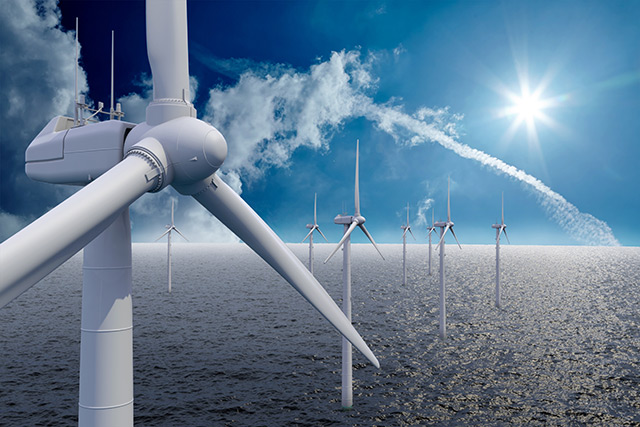
A new study from the Lawrence Berkeley National Laboratory (Berkeley Lab) estimates that future wind power costs will be 50 percent lower than what experts predicted five years ago. This disparity is mainly fueled by lower upfront, operating and financing costs, higher power generation capacity and longer design life. Improvements in these areas hinge upon better turbine technology in the future.
The study was led by researchers from Berkeley Lab, the National Renewable Energy Laboratory, the University of Massachusetts Amherst and the Department of Energy. The researchers detailed their findings in a paper, which is slated to published in the journal Nature Energy.
Better wind turbine technology fuel lower costs
For their study, the researchers surveyed 140 wind energy experts worldwide on three wind applications – land-based, fixed-bottom offshore and floating offshore wind – to identify and compare potential changes in the levelized cost of energy (LCOE) of a standard wind power project. The survey was similar to what Berkeley Lab conducted in 2015.
The LCOE refers to the cost of building and operating an energy asset over a lifetime. It is commonly used to determine whether a project will be worthwhile.
The respondents forecast that wind power's LCOE would decrease 17 to 35 percent by 2035, and 37 to 49 percent by 2050. When technological advancements were considered, the respondents predicted even greater reductions of 38 to 53 percent by 2035 and 54 to 64 percent by 2050. Floating offshore costs would decline fastest, followed by fixed-bottom offshore costs.
These reductions were influenced by continued improvements across five factors: upfront capital cost, operating costs, power generation capacity, project design life and cost of financing. A key driver to these improvements was improved turbine technology.
Pundits were anticipating future land-based wind turbines with longer rotors and higher hubs. Based on experts' turbine size estimates, the power generating capacity would go up from 2.5 megawatts (MW) in 2019 to 5.5 MW by 2035.
Offshore wind turbines were forecast to get even bigger, increasing their capacity from six MW in 2019 to 17 MW by 2035. Experts also predicted floating offshore wind to gain market share. In particular, it was expected to account for up to 25 percent of new offshore wind projects by 2035. (Related: Floating wind farm in Scotland is beginning to show the positive impact of offshore wind farming.)
Joachim Seel, a Berkeley Lab scientist and one of the study's researchers, said that the findings teased a more optimistic future for wind energy.
"All else being equal, these trends will enable wind to play a larger role in global energy supply than previously thought while facilitating energy-sector decarbonization," Seel said. "Analysts, investors, planners and policymakers should avoid outdated assumptions and forecasts."
Wind turbines are really going to get bigger
The study came as multiple original equipment manufacturers (OEM) announced plans to develop much bigger turbines for the offshore sector. Back in 2018, GE Renewable Energy revealed that its Haliade-X turbine would have a tip-height of 853 feet, 351-foot-long blades and a 721-foot rotor. Its capacity could be configured to 12, 13 or 14 MW.
Last February, Danish company Vestas unveiled plans to make a 15-MW turbine with a blade length of 378 feet and a rotor diameter of 774 feet. The firm hoped to install a prototype next year and expand production two years later.
Meanwhile, Spanish-German firm Siemens Gamesa Renewable Energy was working on a 14-MW model, which could be upgraded to 15 MW. The model would have 354-foot blades and a rotor diameter of 728 feet.
By comparison, the average offshore turbine in 2019 had a rotor diameter of 492 feet and a generation capacity of six MW, according to the Berkeley Lab study.
Shashi Barla, a principal analyst at Wood Mackenzie, observed that wind turbine technology was developing at a rapid pace. "You could see a quantum leap in the technology architecture, and the technology specifications on the turbines," Barla told CNBC.
There was a practical reason for these bigger designs. In terms of height, for example, a taller turbine could harness faster wind speeds and produce more electricity in the process. Barla also pointed out that increasing the diameter of a rotor increases the swept area, thus capturing more wind. Additionally, turbines with larger blades operate better in low-wind areas. (Related: Bigger is better when it comes to wind turbines.)
But as OEMs scaled their products up, one thing they would have to resolve was logistics. A tower's components could not be folded once fully constructed, complicating delivery.
"The biggest limiting factor for technology scale up is not the technology itself, but logistics," Barla noted.
Follow NewEnergyReport.com for more on the latest innovations in wind power.
Sources include:
Energy.gov [PDF]
ETA-Publications.LBL.gov [PDF]
Please contact us for more information.














